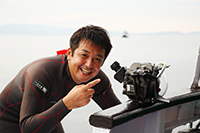YASUAKI KAGII
Born in Hyogo Prefecture in 1971. While still in college, he studied underwater photography under photographer Katsutoshi Ito. After working as a diving guide in the Maldives, Australia, and Izu, he became an independent photographer in 1998 and has continued to photograph the world's oceans. He received the Anima Award in 1998, the Document Photography Award in the Nature Photography Division in 2001, and the Newcomer's Award of the Photographic Society of Japan in 2003.
Review of VF45 1.2x
MDX-PRO 5D Mark II (housing for Canon EOS 5D Mark II) with VF45 1.2x (45° viewfinder) was used for shooting. The lens was a 15mm fisheye lens. The location was the Komodo Islands, at Manta Point in the northern part of the archipelago.
When I first looked through the viewfinder, I felt a slight discomfort, but I tried to concentrate on shooting with the awareness that I was trying something new.
There was a current, so I rode the current and photographed manta rays that appeared one after another from the bottom.
First, I had to get used to the new viewfinder. I checked the manta rays in the viewfinder as I looked through it, and then approached the manta rays while being pushed by the current. At that time, the view in the viewfinder flowed at a lower angle than usual. The undersea current was quite dramatic in the viewfinder, with the image looking like a Star Wars spaceship. First of all, this excited me (laughs).
I take underwater photographs by extending my arm to get closer to the creature. I used to take pictures while "predicting" the range in the tiny viewfinder. I used to say that the viewfinder was the painter's campus, but in fact, since I started using a digital SLR, I have been neglecting it a bit. When I was using a film camera, I used to shoot with a Nikon F4 with an action viewfinder, which gave me a nearly 100% field of view. In exchange, I was able to experience a 100 percent field of view for the first time in a long time.
The results were wonderful.
I was able to check all four corners of the image and take every single shot with care. I was able to check all four corners of the image and take each shot with great care.
I think I was able to shoot from a different distance from the creatures than in the past. This time, I photographed manta rays at a cleaning station, and I was able to get close to them while keeping my eye on the viewfinder. I was afraid that the manta would not like the air I was exhausting. Wouldn't it be difficult to get close to the manta ray? But this time, in a sense, I think I succeeded. I was able to approach the manta ray smoothly by keeping the manta ray firmly in my viewfinder, feeling the "presence and tension" in the margins other than the manta ray, and keeping my mind clear.
We also dived at a point with abundant coral.
Here, too, I was able to check all four corners of the viewfinder before proceeding with the shoot. By doing so, I think I was able to pay close attention to the beauty of the coral reef's formations.
Anyway, what I felt was a direct connection between the world I could see through the viewfinder and my work.
It is true that there may be a delay of one tempo in the timing of setting the viewfinder to the vertical position, and there may be some confusion about the eye point when you are not used to it, but at this point, the VF45 1.2x (45° viewfinder) is indispensable for my wide-angle photography from now on. I am now able to use it for my wide-angle photography.
*Copyright of these image data belongs to SEA&SEA Corporation or the photographer indicated.

